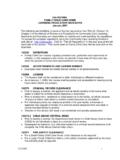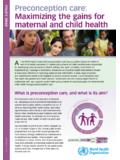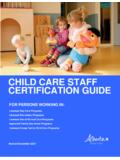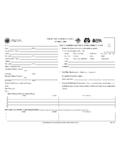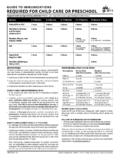Transcription of Child Care Facilities Development Checklists
1 BUILDING. Child . care . A California Statewide Collaborative Child care Center Facility Development Checklists When planning to expand, renovate, build or purchase a Child care center, it is essential to think through the entire process by breaking activities down into four stages: planning, predevelopment, Development , and start-up. Though the steps laid out in these stages are listed sequentially here, some may occur simultaneously and others might not be necessary depending on the type and scale of your project. While this list represents a number of the activities involved in a Child care center Facilities Development project, each project varies and so in addition to reviewing these steps you should also be sure to identify what other steps might be required for your own project.
2 This document was prepared by the Building Child care Project, a California statewide collaborative designed to help Child care providers navigate the process of financing and developing Facilities . For more information about this project and its services, please call (888) 411-3535, or visit the website at *. PLANNING STAGE. 1. Market Demand a. Estimate the number of families demanding services in your area at the rate to be charged. Note: this is not an estimate of those who just need services, but of those who demand the services and can pay your rates or can use parent vouchers. Contact the Resource and Referral Agency (R&R) and the Local Child care Planning Council (LPC) in your community to find out about the demand and highest need for care in your area, as well as information about the existing supply of Child care services in the community.
3 B. Decide whether your services will target low-income, middle-income, and/or affluent families. This decision will affect both the rates you charge and your eligibility for subsidy programs. c. Decide what age group(s) your services will cater to. This will affect your assessment of local supply and demand. Keep in mind that different age groups have different requirements for both staff and room size, which will impact your operational budget and site selection. d. Assess whether or not the rates you intend to charge will generate enough revenues to meet the costs of operating expenses and the debt incurred by the facility Development project. e. Begin to write a business plan that addresses these issues.
4 For assistance with business planning for your Child care business, contact the Small Business Administration to find out what local resources are available to you ( Small Business Development Centers, Women's Business Centers, and/or Service Corps of Retired Executives advisors). This information can be found at 1-800-8- ASK-SBA, or online at If you are developing a nonprofit center then other resources may be available through local nonprofit management assistance programs as well. 2. Financial Feasibility a. Estimate the overall start-up or capital cost of the facility Development process. A contractor can help you with these estimates. Divide the overall costs into: ! Soft costs (design, permits, legal, and financing fees), !
5 Hard costs (acquisition, construction, equipment), ! Hidden costs (staff and board time and attention), ! Contingency costs (a portion of construction costs set aside to cover unexpected costs), and ! Lost income (if the program has to close for any period of time during construction). b. Design, or update, an operating budget for your Child care business. In identifying your expected revenues (incoming money from parent fees and vouchers, state subsidies, etc.) you shouldn't project that your program will be more than 90% full because it usually takes at minimum six months to reach *The planning stage is perhaps the most essential in any Facilities Development process, because the more time and attention that goes into planning the project, the less likely it is that you'll face costly mistakes in the later stages.
6 Additionally, careful attention to the steps in the planning stage allows you to learn early on if you or your business are not ready to take on the financial risk of a Facilities Development project. Building Child care A California Statewide Collaborative 1. capacity, and even then it is quite common for enrollments to fluctuate throughout the year. c. Identify the financing you will need to cover your start-up and operating budgets. You may need to adjust your budget projections as you figure out more specific details about your incoming revenues. d. Analyze your capability to apply for financing ( loans) by determining debt capacity, or debt service coverage (for definitions see the Glossary of Loan Terms at or in the Matrix).
7 E. Ensure that you will have enough working capital (cash available to fill in the gap between revenue and expenses) at the end of the facility Development process to cover at minimum 3 months of operating expenses because revenues take time to come in as enrollment builds. It is best to have a larger cash reserve if possible to prepare for any cash flow problems that may occur, especially for new programs. f. Identify donor relationships and look into new ones for Development grants and for donations of toys, equipment, furniture, dress-up clothes, building supplies, etc. You should also identify potential partnerships with other community organizations like churches, hospitals, and schools that might be able to collaborate with you to provide certain services and share some expenses.
8 G. Determine your legal status as a nonprofit or for profit Child care program. This will directly affect your approach to obtaining financing. To become a nonprofit you will need to establish a Board of Directors, form a nonprofit corporation 501c(3), and file for your tax-exempt status with the IRS. To become a for-profit you will need to decide if you want to be a sole proprietor, a corporation, or a partnership. 3. Organizational Capacity a. Establish a Development team of individuals to lead the facility Development project. Seek volunteer, pro bono, or in-kind assistance before hiring paid consultants. b. Ensure that the staff, the board, and the leader(s) share a commitment to take this project in the same direction, and assess whether you have the staff/skills needed for the long-term process of facility Development .
9 C. Evaluate your financial readiness as an organization by identifying red and green flags: Red flags: difficulty paying bills, deficits in recent years, large amounts of uncollected receivables such as parent fees, and a lack of any cushion or cash reserve. Green flags: services are constrained by a lack of space, you are in a financially strong and growing position, and there is a clear demand for your services d. Identify local support - know the community and the demand for services; have relationships beyond just the early care and education field; and make sure the community knows what you have to offer. MONEY NEEDED DURING THIS STAGE: Equity (planning grants, internal resources).
10 And limited Debt (soft loans). Building Child care A California Statewide Collaborative 2. PREDEVELOPMENT STAGE. 1. Site Selection Expanding or Renovating an existing facility: Evaluate the site and the neighborhood in relation to the project concept, the size of the lot, zoning and licensing requirements, health and safety issues, the quality of the existing structure, and design, engineering, repair and renovation costs. Finding a new site: Evaluate the site in relation to the project concept, site costs (direct and indirect), quality of the neighborhood, licensing requirements, zoning and land use restrictions, size, plans for new developments in the area, health and safety issues, infrastructure (utilities, roads, easements), traffic patterns, transportation, parking, and access to the building.


